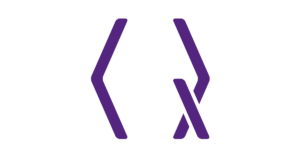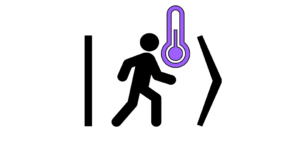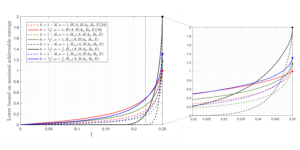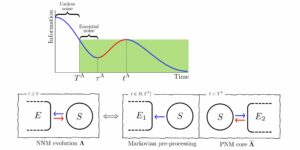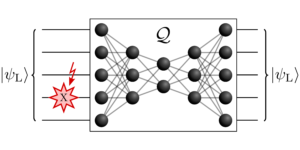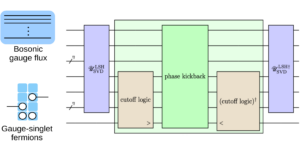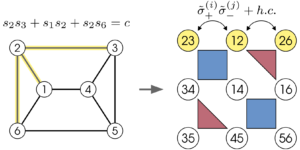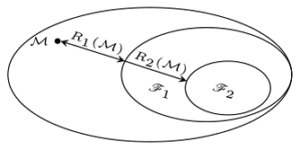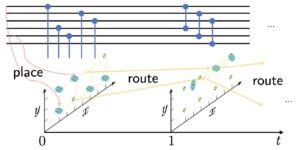1Institute for Theoretical Physics, University of Innsbruck, Technikerstraße 21A, 6020 Innsbruck, Austria
2Institute for Quantum Optics and Quantum Information (IQOQI), Austrian Academy of Sciences, Boltzmanngasse 3, 1090 Vienna, Austria
3Naturwissenschaftlich-Technische Fakultät, Universität Siegen, Walter-Flex-Straße 3, 57068 Siegen, Germany
Find this paper interesting or want to discuss? Scite or leave a comment on SciRate.
Abstract
Recent advances have led towards first prototypes of quantum networks in which entanglement is distributed by sources producing bipartite entangled states. This raises the question of which states can be generated in quantum networks based on bipartite sources using local operations and classical communication. In this work, we study state transformations under finite rounds of local operations and classical communication (LOCC) in networks based on maximally entangled two-qubit states. We first derive the symmetries for arbitrary network structures, as these determine which transformations are possible. Then, we show that contrary to tree graphs, for which it has already been shown that any state within the same entanglement class can be reached, there exist states which can be reached probabilistically but not deterministically if the network contains a cycle. Furthermore, we provide a systematic way to determine states which are not reachable in networks consisting of a cycle. Moreover, we provide a complete characterization of the states which can be reached in a cycle network with a protocol where each party measures only once, and each step of the protocol results in a deterministic transformation. Finally, we present an example which cannot be reached with such a simple protocol, and constitutes, up to our knowledge, the first example of a LOCC transformation among fully entangled states requiring three rounds of classical communication.
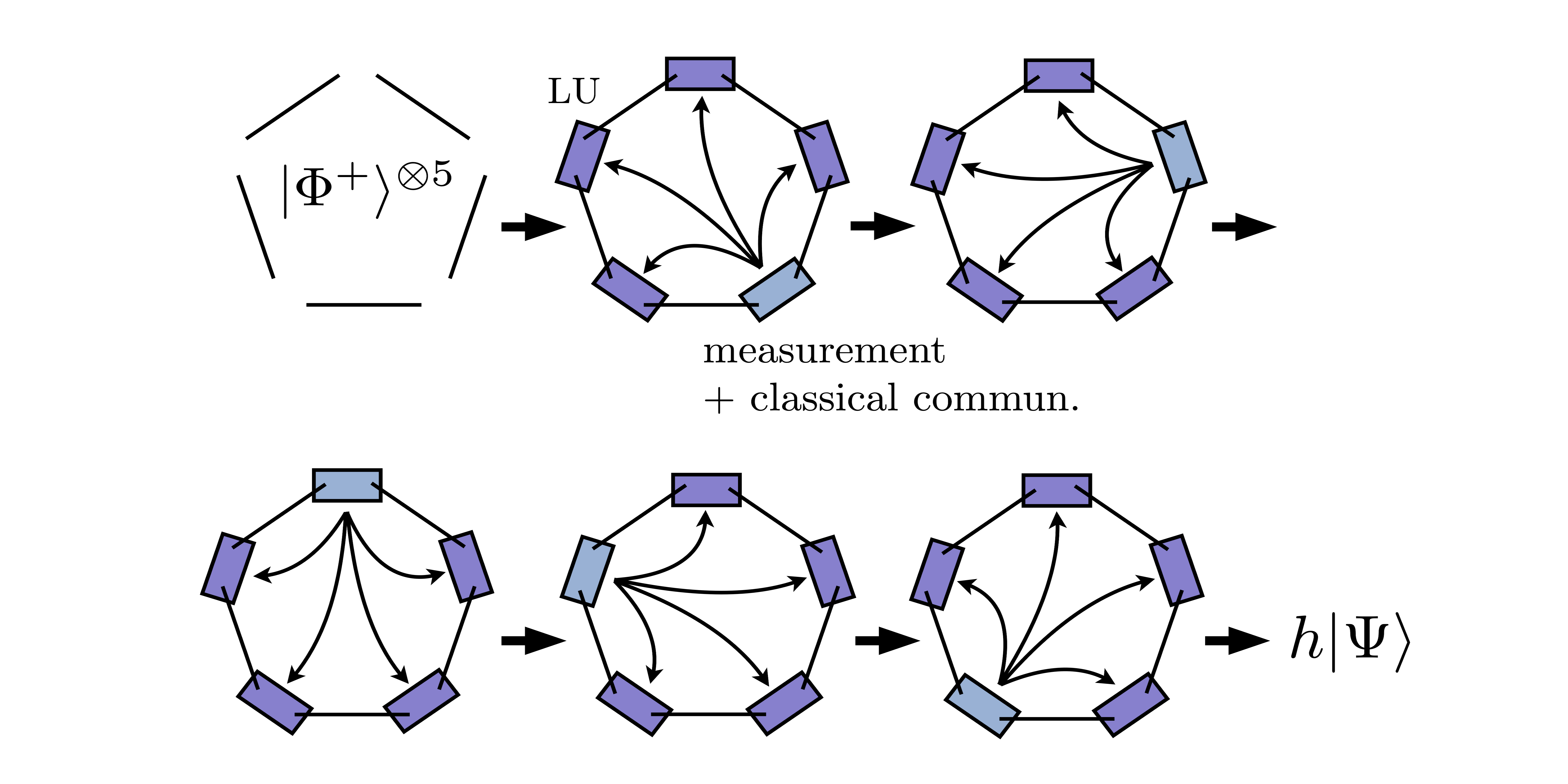
Featured image: A finite round LOCC protocol in a cycle network transforming the initial state $|Phi^+rangle^{otimes 5}$ to a target state $h |Psirangle$.
► BibTeX data
► References
[1] H. J. Kimble, Nature 453, 1023 (2008).
https://doi.org/10.1038/nature07127
[2] S. Wehner, D. Elkouss and R. Hanson, Science 362, 9288 (2018).
https://doi.org/10.1126/science.aam9288
[3] J. I. Cirac, P. Zoller, H. J. Kimble, and H. Mabuchi, Phys. Rev. Lett. 78, 3221 (1997).
https://doi.org/10.1103/PhysRevLett.78.3221
[4] L.-M. Duan and C. Monroe, Rev. Mod. Phys. 82, 1209 (2010).
https://doi.org/10.1103/RevModPhys.82.1209
[5] A. Reiserer and G. Rempe, Rev. Mod. Phys. 87,1379 (2015).
https://doi.org/10.1103/RevModPhys.87.1379
[6] L.-M. Duan, M. D. Lukin, J. I. Cirac, P. Zoller, Nature 414, 413 (2001).
https://doi.org/10.1038/35106500
[7] J. I. Cirac, A. K. Ekert, S. F. Huelga, and C. Macchiavello, Phys. Rev. A 59, 4249 (1999).
https://doi.org/10.1103/PhysRevA.59.4249
[8] T. P. Spiller, K. Nemoto, S. L. Braunstein, W. J. Munro, P. van Loock, and G. J. Milburn, New J. Phys. 8, 30 (2006).
https://doi.org/10.1088/1367-2630/8/2/030
[9] K. Azuma, S. Bäuml, T. Coopmans, D. Elkouss, B. Li, AVS Quantum Sci. 3, 014101 (2021).
https://doi.org/10.1116/5.0024062
[10] N. Gisin, J.-D. Bancal, Y. Cai, P. Remy, A. Tavakoli, E. Zambrini Cruzeiro, S. Popescu, N. Brunner, Nat. Commun. 11, 2378 (2020).
https://doi.org/10.1038/s41467-020-16137-4
[11] T. Kraft, S. Designolle, C. Ritz, N.Brunner, O. Gühne, and M. Huber, Phys. Rev. A. 103, L060401 (2021).
https://doi.org/10.1103/PhysRevA.103.L060401
[12] M. Navascués, E. Wolfe, D. Rosset, and A. Pozas-Kerstjens, Phys. Rev. Lett. 125, 240505 (2020).
https://doi.org/10.1103/PhysRevLett.125.240505
[13] M.-X. Luo, Adv. Quantum Technol., 2000123 (2021).
https://doi.org/10.1002/qute.202000123
[14] J. Åberg, R. Nery, C. Duarte, R. Chaves, Phys. Rev. Lett. 125, 110505 (2020).
https://doi.org/10.1103/PhysRevLett.125.110505
[15] T. Kraft, C. Spee, X.-D. Yu, and O. Gühne, Phys. Rev. A 103, 052405 (2021).
https://doi.org/10.1103/PhysRevA.103.052405
[16] K. Hansenne, Z.-P. Xu, T. Kraft, and O. Gühne, Nat. Commun. 13, 496 (2022).
https://doi.org/10.1038/s41467-022-28006-3
[17] C. H. Bennett, G. Brassard, C. Crépeau, R. Jozsa, A. Peres, and W. K. Wootters, Phys. Rev. Lett. 70, 1895 (1993).
https://doi.org/10.1103/PhysRevLett.70.1895
[18] A. Acín, J. Cirac, M. Lewenstein, Nature Physics 3, 256 (2007).
https://doi.org/10.1038/nphys549
[19] M. A. Nielsen, Phys. Rev. Lett. 83, 436 (1999).
https://doi.org/10.1103/PhysRevLett.83.436
[20] W. Dür, G. Vidal, and J.I. Cirac, Phys. Rev. A 62,062314 (2000).
https://doi.org/10.1103/PhysRevA.62.062314
[21] F. Verstraete, J. Dehaene, B. De Moor, and H. Verschelde, Phys. Rev. A 65, 052112 (2002).
https://doi.org/10.1103/PhysRevA.65.052112
[22] M. J. Donald, M. Horodecki, and O. Rudolph, J. Math. Phys. 43, 4252 (2002).
https://doi.org/10.1063/1.1495917
[23] E. Chitambar, Phys. Rev. Lett. 107, 190502 (2011).
https://doi.org/10.1103/PhysRevLett.107.190502
[24] E. Chitambar, W. Cui, and H.-K-. Lo, Phys. Rev. Lett. 108, 240504 (2012).
https://doi.org/10.1103/PhysRevLett.108.240504
[25] E. Chitambar, D. Leung, L. Mancinska, M. Ozols, A. Winter, Commun. Math. Phys. 328, 303 (2014).
https://doi.org/10.1007/s00220-014-1953-9
[26] S. M. Cohen, Phys. Rev. Lett. 118, 020501 (2017).
https://doi.org/10.1103/PhysRevLett.118.020501
[27] S. Turgut, Y. Gül, and N. K. Pak, Phys. Rev. A 81, 012317 (2010).
https://doi.org/10.1103/PhysRevA.81.012317
[28] S. Kintas and S. Turgut, J. Math. Phys. 51, 092202 (2010).
https://doi.org/10.1063/1.3481573
[29] C. Spee, J.I. de Vicente, D. Sauerwein, B. Kraus, Phys. Rev. Lett. 118, 040503 (2017).
https://doi.org/10.1103/PhysRevLett.118.040503
[30] J.I. de Vicente, C. Spee, D. Sauerwein, B. Kraus, Phys. Rev. A 95, 012323 (2017).
https://doi.org/10.1103/PhysRevA.95.012323
[31] J. I. de Vicente, C. Spee, and B. Kraus, Phys. Rev. Lett. 111, 110502 (2013).
https://doi.org/10.1103/PhysRevLett.111.110502
[32] K. Schwaiger, D. Sauerwein, M. Cuquet, J. I. de Vicente, B. Kraus, Phys. Rev. Lett. 115, 150502 (2015).
https://doi.org/10.1103/PhysRevLett.115.150502
[33] C. Spee, J. I. de Vicente, B. Kraus, J. Math. Phys. 57, 052201 (2016).
https://doi.org/10.1063/1.4946895
[34] M. Hebenstreit, C. Spee, and B. Kraus, Phys. Rev. A 93, 012339 (2016).
https://doi.org/10.1103/PhysRevA.93.012339
[35] H. Yamasaki, A. Soeda, and M. Murao, Phys. Rev. A 96, 032330 (2017).
https://doi.org/10.1103/PhysRevA.96.032330
[36] M. Hebenstreit, M. Englbrecht, C. Spee, J. I. de Vicente, and B. Kraus, New J. Phys. 23, 033046 (2021).
https://doi.org/10.1088/1367-2630/abe60c
[37] G. Gour and N. R. Wallach, New J. Phys. 13, 073013 (2011).
https://doi.org/10.1088/1367-2630/13/7/073013
[38] G Gour and N. R. Wallach, New J. Phys. 21, 109502 (2019).
https://doi.org/10.1088/1367-2630/ab4c88
[39] D. Sauerwein, A. Molnar, J. I. Cirac, and B. Kraus, Phys. Rev. Lett. 123, 170504 (2019).
https://doi.org/10.1103/PhysRevLett.123.170504
[40] M. Hebenstreit, C. Spee, N. K. H. Li, B. Kraus, J. I. de Vicente, Phys. Rev. A 105, 032458 (2022).
https://doi.org/10.1103/PhysRevA.105.032458
[41] F. Verstraete, J. Dehaene, and B. De Moor, Phys. Rev. A 64, 010101(R) (2001).
https://doi.org/10.1103/PhysRevA.64.010101
[42] H.-K. Lo and S. Popescu, Phys. Rev. A, 63, 022301 (2001).
https://doi.org/10.1103/PhysRevA.63.022301
Cited by
[1] Kiara Hansenne, Zhen-Peng Xu, Tristan Kraft, and Otfried Gühne, “Symmetries in quantum networks lead to no-go theorems for entanglement distribution and to verification techniques”, Nature Communications 13, 496 (2022).
[2] Patricia Contreras-Tejada, Carlos Palazuelos, and Julio I. de Vicente, “Asymptotic Survival of Genuine Multipartite Entanglement in Noisy Quantum Networks Depends on the Topology”, Physical Review Letters 128 22, 220501 (2022).
[3] Nicky Kai Hong Li, Cornelia Spee, Martin Hebenstreit, Julio I. de Vicente, and Barbara Kraus, “Identifying families of multipartite states with non-trivial local entanglement transformations”, Quantum 8, 1270 (2024).
[4] Owidiusz Makuta, Laurens T. Ligthart, and Remigiusz Augusiak, “No graph state is preparable in quantum networks with bipartite sources and no classical communication”, npj Quantum Information 9, 117 (2023).
[5] Simon Morelli, David Sauerwein, Michalis Skotiniotis, and Nicolai Friis, “Metrology-assisted entanglement distribution in noisy quantum networks”, Quantum 6, 722 (2022).
The above citations are from SAO/NASA ADS (last updated successfully 2024-03-15 03:31:06). The list may be incomplete as not all publishers provide suitable and complete citation data.
On Crossref’s cited-by service no data on citing works was found (last attempt 2024-03-15 03:31:05).
This Paper is published in Quantum under the Creative Commons Attribution 4.0 International (CC BY 4.0) license. Copyright remains with the original copyright holders such as the authors or their institutions.
- SEO Powered Content & PR Distribution. Get Amplified Today.
- PlatoData.Network Vertical Generative Ai. Empower Yourself. Access Here.
- PlatoAiStream. Web3 Intelligence. Knowledge Amplified. Access Here.
- PlatoESG. Carbon, CleanTech, Energy, Environment, Solar, Waste Management. Access Here.
- PlatoHealth. Biotech and Clinical Trials Intelligence. Access Here.
- Source: https://quantum-journal.org/papers/q-2024-03-14-1286/
- :has
- :is
- :not
- :where
- ][p
- $UP
- 06
- 1
- 10
- 11
- 118
- 12
- 125
- 13
- 14
- 15%
- 16
- 17
- 19
- 1999
- 20
- 2000
- 2001
- 2006
- 2008
- 2011
- 2012
- 2013
- 2014
- 2015
- 2016
- 2017
- 2018
- 2019
- 2020
- 2021
- 2022
- 2023
- 2024
- 22
- 23
- 24
- 25
- 26%
- 27
- 28
- 29
- 30
- 31
- 32
- 33
- 35%
- 36
- 362
- 39
- 40
- 41
- 43
- 51
- 65
- 7
- 70
- 8
- 87
- 9
- a
- above
- ABSTRACT
- Academy
- access
- advances
- affiliations
- All
- already
- among
- an
- and
- any
- arbitrary
- ARE
- AS
- assisted
- attempt
- austrian
- author
- authors
- based
- BE
- been
- Break
- but
- by
- CAN
- cannot
- carlos
- class
- cohen
- comment
- Commons
- Communication
- Communications
- complete
- Consisting
- contains
- contrary
- copyright
- Cornelia
- cycle
- data
- David
- de
- depends
- derive
- Determine
- discuss
- distributed
- distribution
- donald
- e
- each
- entanglement
- example
- exist
- families
- Finally
- First
- For
- found
- from
- fully
- Furthermore
- generated
- genuine
- graph
- graphs
- harvard
- Have
- holders
- Hong
- HTTPS
- i
- identifying
- if
- image
- in
- information
- initial
- institutions
- interesting
- International
- IT
- JavaScript
- journal
- knowledge
- Last
- lead
- Leave
- Led
- Li
- License
- List
- local
- many
- mar
- Martin
- math
- max-width
- May..
- measures
- Month
- Moreover
- Nature
- network
- networks
- New
- no
- of
- on
- once
- only
- open
- Operations
- optics
- or
- original
- our
- pages
- Paper
- party
- Physics
- plato
- Plato Data Intelligence
- PlatoData
- possible
- present
- probabilistically
- producing
- protocol
- prototypes
- provide
- published
- publisher
- publishers
- Quantum
- quantum information
- quantum networks
- Quantum optics
- question
- R
- raises
- reached
- references
- remains
- Results
- review
- round
- rounds
- s
- same
- SCI
- Science
- SCIENCES
- show
- shown
- Simon
- Simple
- Sources
- State
- States
- Step
- structures
- Study
- Successfully
- such
- suitable
- survival
- Target
- techniques
- that
- The
- their
- then
- theoretical
- There.
- These
- this
- three
- Title
- to
- towards
- Transformation
- transformations
- transforming
- tree
- under
- university
- updated
- URL
- using
- van
- Verification
- via
- volume
- W
- want
- was
- Way..
- we
- which
- Winter
- with
- within
- Work
- works
- X
- year
- zephyrnet



